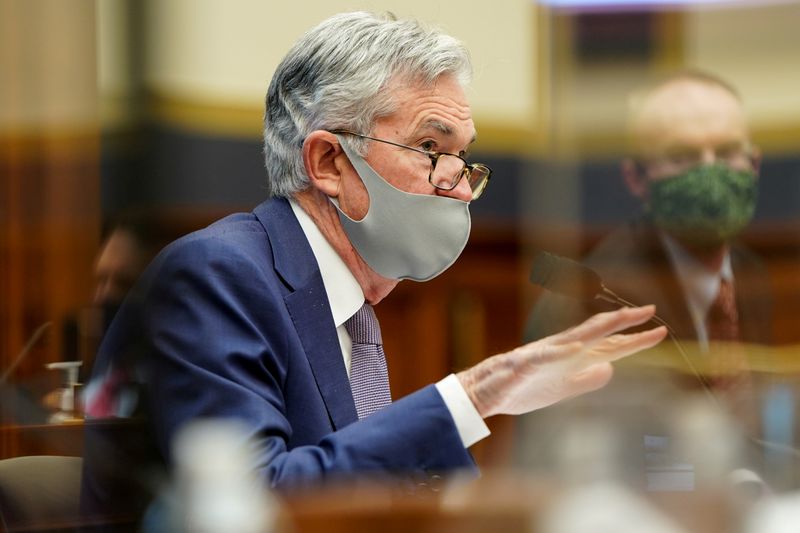By Geoffrey Smith
Investing.com -- Federal Reserve Chairman Jerome Powell starts two days of Congressional testimony as fears about inflation push 30-year bond yields to new highs. Lucid Motors finally ties up its deal with Michael Klein’s SPAC Churchill Capital IV , Bitcoin and Ethereum plunge but sterling and U.K. stocks surge after Boris Johnson maps out a road out of lockdown. Here’s what you need to know in financial markets on Tuesday, February 23rd.
1. Jerome Powell and the great inflation scare
Federal Reserve chief Jerome Powell starts two days of testimony to Congress on the state of the economy, at a moment when concerns about inflation are triggering a heavy sell-off in long-dated bonds.
Powell’s appearance promises to be the highlight of the week for global markets, giving the clearest indication of whether the Fed will remain committed to letting the economy to run hot in order to quicken and complete the economic recovery from the pandemic.
The Fed’s repeated assurances that it will keep policy loose this year have been one of the factors behind the sharp run up in assets such as commodities, as well as other assets that are implicit bets on dollar devaluation.
2. Crypto sell-off gains pace
First and foremost among such dollar-devaluation bets have been cryptocurrencies, which are correcting sharply as investors take profits on what has been an extreme move over the last three months.
Bitcoin prices fell another 13.6% overnight to $47,410 on the Bitfinex exchange. They’ve now fallen 20% from their peak two days ago, although they’re still up by more than two-third since the start of the year, a rally driven by a rapidly expanding range of ways to play the asset.
The sell-off was sparked over the weekend by a tweet from Tesla (NASDAQ:TSLA) CEO Elon Musk, who noted that prices for Bitcoin and Ethereum seemed “quite high” after their recent runups. Ethereum was down 19.5% overnight at $1,463.
3. Tech set to drive stocks lower again; Home Depot , Medtronic report
Tech stocks are set to drag U.S. markets lower for a second straight day when they open later, as concerns about a possible slowdown in money-printing by the Fed raises the incentive to take some profits on a rally that now stretches back years.
By 6:30 AM ET (1130 GMT), Dow Jones futures were down 60 points, or 0.2%, while S&P 500 futures were down 0.6%, but Nasdaq 100 futures were down a hefty 1.5%, extending losses of 2% posted on Monday.
Among stocks likely to be in focus are Tesla (NASDAQ:TSLA) and Churchill Capital IV (NYSE:CCIV), the SPAC which overnight formally announced the terms of its merger with Tesla rival Lucid Motors. Tesla lost 8.6% on Monday on the emergence of its first real U.S.-based challenger in the luxury electric vehicle segment.
Also under the microscope will be Home Depot (NYSE:HD), whose stock fell 1.5% in premarket trading after it said it couldn’t say whether 2021 will be as strong as 2020, when it rode a pandemic-driven boom for home improvement. Medical device maker Medtronic (NYSE:MDT) is also due to report before the open.
4. U.K. assets surge as Johnson outlines exit from lockdown
The pound hit its highest in a year against the euro and its highest since April 2018 against the dollar after Prime Minister Boris Johnson outlined what he called a “cautious and irreversible” path out of lockdown by July.
U.K. stocks also surged in response to Johnson’s TV address, given late on Monday. The FTSE 250, a midcap index that concentrates on domestic-focused stocks, rose nearly 1%, while the FTSE 100 also outperformed other European markets, which followed the general downward trajectory on Wall Street on Monday.
Johnson’s upbeat address overshadowed labor market data on Tuesday morning that showed unemployment reaching its highest in five years in December, along with another 114,000 contraction in employment over the last three months.
5. Rotation in commodity rally
Agricultural commodities were playing catch-up with industrial ones in overnight trading, on perceptions that base metals have moved too far, too fast.
Coffee, oats, rough rice and soybeans were all outperforming copper, aluminum and zinc on confidence in a broad-based increase in consumer spending power.
Crude oil futures, meanwhile, retreated from another 13-month high, which they had posted on the back of reports that Goldman Sachs analysts now see the rally going as far as $70 a barrel. By 6:30 AM ET, U.S. crude futures were up 0.9% at $62.26 a barrel, while Brent crude was up 0.8% at $64.89 a barrel. The American Petroleum Institute releases its weekly assessment of U.S. stockpiles at 4:30 PM ET.
